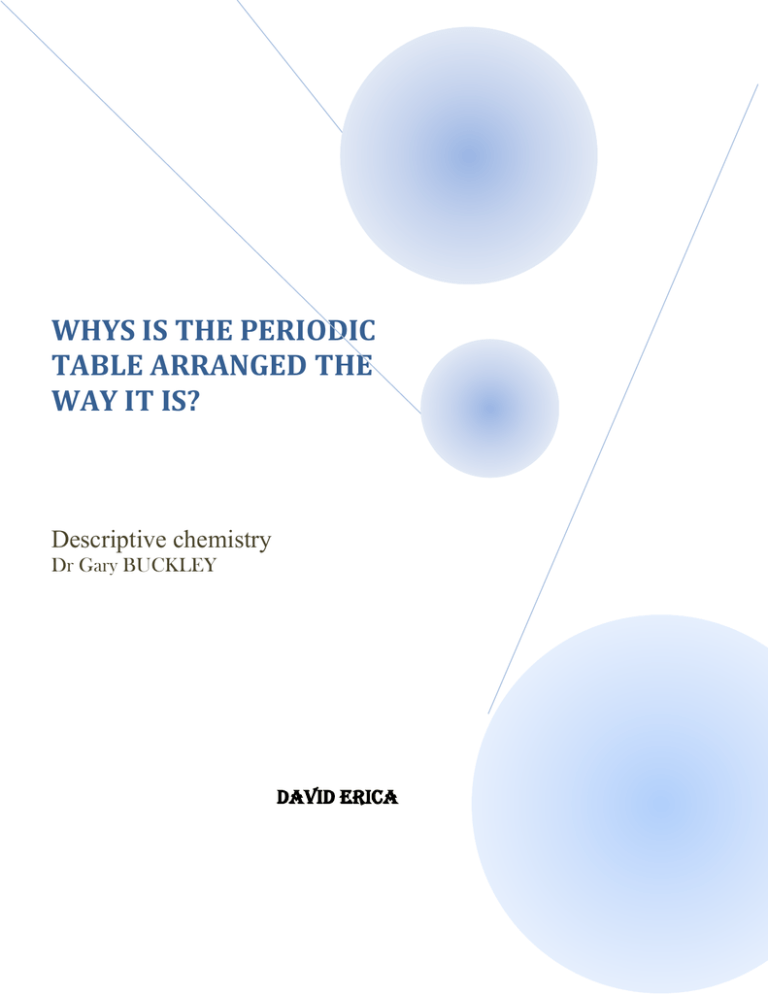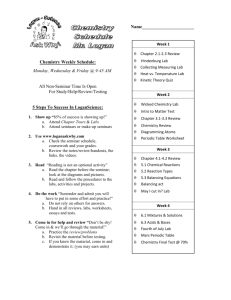
WHYS IS THE PERIODIC
TABLE ARRANGED THE
WAY IT IS?
Descriptive chemistry
Dr Gary BUCKLEY
DAVID ERICA
The periodic table of the chemical elements is a tabular exhibition of the chemical elements.
There were various attempts to arrange the elements. These are: the Dobeiner’s “triads” by
Johann Dobereiner in 1816, the De Chancourtois’s “Telluric helix” by Beguyer De Chancourtois
in 1862, Newlands’s “Law of Octaves” by John Newlands in 1863, Meyer’s system of element
by Julius Lothar Meyer in 1868 and Mendeleev’s periodic table by Dmitri Ivanovich Mendeleev
in 1869.[1] The most successful attempt was Mendeleev’s periodic table.[2] The periodic table
has been refined and extend as the new elements have been discovered. The layout of the
elements has been refined and extended over the time as the elements have been discovered. In
this essay, I will try to explain why the periodic table is arranged the way it is.
In one hand, Mendeleev’s periodic table arranged the element primarily in order of increasing
the atomic mass, although in a few cases he put the slightly heavier element before one in order
to place element with similar chemical properties in the same column.[3] I believe that he has
arranged the elements in this way because he want to show the lightest and the heaviest element
but at the same time keep elements which have similarities in chemical properties together. I can
take the example of the fact that he put tellurium, with an atomic mass of 127.6 u, ahead of
iodine, which has an atomic mass of 126.9 u.[4] As you can see in the table 2 below, he placed
tellurium in the same column as sulfur and selenium because it has similar chemical properties
like them. He also leaves blanks in his table which was a predilection of the discovery of new
elements.
In another hand, the new periodic table is arranged by boxes.[5] Each vertical column is called a
group or family and horizontal row is called a period. [6] I find that the method above especially
the fact that the vertical column is called a group or a family is a very important method to
classify elements which have the same chemical properties. For example, group1 is the alkali
metals, group2 is alkaline earth metals, group16 is chalogens, group 17 is halogens and group 18
is noble gases. Also, group1, 2, 13 through 18 are called representative elements, group3 through
12 are called transition metals.[7] Some group in the periodic table have elements with similar in
chemical properties but these have no particular name, we just use their group number. As an
example I can take the group 14.[8] The periodic table is also arranged by blocs, named
according to the subshell in which the last electron resides. The s-block comprises the first two
groups, and contains hydrogen and helium. The p-block comprises the last six groups, group 13
through 18 and contains all the semimetal. The d-block comprises group 3 through 12 and
contains all the transition metals. The f-block comprises the rare earth metals.[9]
To sum up I can say that the main value of the periodic table is the ability to predict the chemical
properties of an element based on its location on the table. [10] As long as you move in the
periodic table vertically, you can see that the element have similarities based on the fact that they
belong to the same family. Also you can see that they are arranged by blocks which represent the
different subshell where the last electron resides.
1-PERIODIC TABLE
2-PERIODIC TABLE WITH ATOMIC MASS
References:
1- Chemistry for changing times, p 51 and Its story and its significance p 63
2- Chemistry for changing times, p 51
3- Chemistry for changing times, p 51
4- Chemistry for changing times, p 51
5- Chemistry for changing times, p 51
6- Chemistry for changing times, p 80
7- Chemistry for changing times, p 82 figure 3.17
8- Chemistry: The Central Science (tenth edition).
9- Chemistry: The Central Science (tenth edition).
10- Chemistry: The Central Science (tenth edition).
Sources:
- Scerri, Eric R. (2007). Its Story and Its Significance. Oxford, New York Oxford University
Press.
- John W. Hill, Terry W. McCreary, Doris K Kolb. (2010). Chemistry for changing times
(twelfth edition). Pearson Prentice hall.
- Brown, Theodore L.; LeMay, H. Eugene; Bursten, Bruce E. (2005). Chemistry: The Central
Science (tenth edition). Prentice Hal from http://en.wikipedia.org/wiki/Periodic_table



